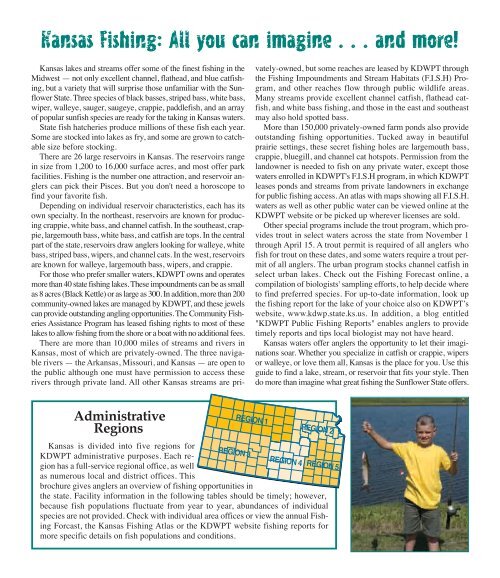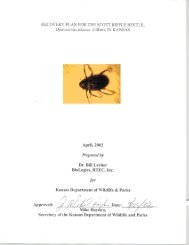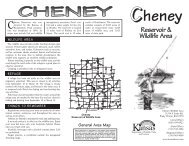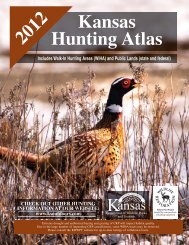Fishing Guide - Kansas Department of Wildlife and Parks
Fishing Guide - Kansas Department of Wildlife and Parks
Fishing Guide - Kansas Department of Wildlife and Parks
You also want an ePaper? Increase the reach of your titles
YUMPU automatically turns print PDFs into web optimized ePapers that Google loves.
<strong>Kansas</strong> <strong>Fishing</strong>: All you can imagine . . . <strong>and</strong> more!<strong>Kansas</strong> lakes <strong>and</strong> streams <strong>of</strong>fer some <strong>of</strong> the finest fishing in theMidwest — not only excellent channel, flathead, <strong>and</strong> blue catfishing,but a variety that will surprise those unfamiliar with the SunflowerState. Three species <strong>of</strong> black basses, striped bass, white bass,wiper, walleye, sauger, saugeye, crappie, paddlefish, <strong>and</strong> an array<strong>of</strong> popular sunfish species are ready for the taking in <strong>Kansas</strong> waters.State fish hatcheries produce millions <strong>of</strong> these fish each year.Some are stocked into lakes as fry, <strong>and</strong> some are grown to catchablesize before stocking.There are 26 large reservoirs in <strong>Kansas</strong>. The reservoirs rangein size from 1,200 to 16,000 surface acres, <strong>and</strong> most <strong>of</strong>fer parkfacilities. <strong>Fishing</strong> is the number one attraction, <strong>and</strong> reservoir anglerscan pick their Pisces. But you don't need a horoscope t<strong>of</strong>ind your favorite fish.Depending on individual reservoir characteristics, each has itsown specialty. In the northeast, reservoirs are known for producingcrappie, white bass, <strong>and</strong> channel catfish. In the southeast, crappie,largemouth bass, white bass, <strong>and</strong> catfish are tops. In the centralpart <strong>of</strong> the state, reservoirs draw anglers looking for walleye, whitebass, striped bass, wipers, <strong>and</strong> channel cats. In the west, reservoirsare known for walleye, largemouth bass, wipers, <strong>and</strong> crappie.For those who prefer smaller waters, KDWPT owns <strong>and</strong> operatesmore than 40 state fishing lakes. These impoundments can be as smallas 8 acres (Black Kettle) or as large as 300. In addition, more than 200community-owned lakes are managed by KDWPT, <strong>and</strong> these jewelscan provide outst<strong>and</strong>ing angling opportunities. The Community FisheriesAssistance Program has leased fishing rights to most <strong>of</strong> theselakes to allow fishing from the shore or a boat with no additional fees.There are more than 10,000 miles <strong>of</strong> streams <strong>and</strong> rivers in<strong>Kansas</strong>, most <strong>of</strong> which are privately-owned. The three navigablerivers — the Arkansas, Missouri, <strong>and</strong> <strong>Kansas</strong> — are open tothe public although one must have permission to access theserivers through private l<strong>and</strong>. All other <strong>Kansas</strong> streams are privately-owned,but some reaches are leased by KDWPT throughthe <strong>Fishing</strong> Impoundments <strong>and</strong> Stream Habitats (F.I.S.H) Program,<strong>and</strong> other reaches flow through public wildlife areas.Many streams provide excellent channel catfish, flathead catfish,<strong>and</strong> white bass fishing, <strong>and</strong> those in the east <strong>and</strong> southeastmay also hold spotted bass.More than 150,000 privately-owned farm ponds also provideoutst<strong>and</strong>ing fishing opportunities. Tucked away in beautifulprairie settings, these secret fishing holes are largemouth bass,crappie, bluegill, <strong>and</strong> channel cat hotspots. Permission from thel<strong>and</strong>owner is needed to fish on any private water, except thosewaters enrolled in KDWPT's F.I.S.H program, in which KDWPTleases ponds <strong>and</strong> streams from private l<strong>and</strong>owners in exchangefor public fishing access. An atlas with maps showing all F.I.S.H.waters as well as other public water can be viewed online at theKDWPT website or be picked up wherever licenses are sold.Other special programs include the trout program, which providestrout in select waters across the state from November 1through April 15. A trout permit is required <strong>of</strong> all anglers wh<strong>of</strong>ish for trout on these dates, <strong>and</strong> some waters require a trout permit<strong>of</strong> all anglers. The urban program stocks channel catfish inselect urban lakes. Check out the <strong>Fishing</strong> Forecast online, acompilation <strong>of</strong> biologists' sampling efforts, to help decide whereto find preferred species. For up-to-date information, look upthe fishing report for the lake <strong>of</strong> your choice also on KDWPT’swebsite, www.kdwp.state.ks.us. In addition, a blog entitled"KDWPT Public <strong>Fishing</strong> Reports" enables anglers to providetimely reports <strong>and</strong> tips local biologist may not have heard.<strong>Kansas</strong> waters <strong>of</strong>fer anglers the opportunity to let their imaginationssoar. Whether you specialize in catfish or crappie, wipersor walleye, or love them all, <strong>Kansas</strong> is the place for you. Use thisguide to find a lake, stream, or reservoir that fits your style. Thendo more than imagine what great fishing the Sunflower State <strong>of</strong>fers.AdministrativeRegionsREGION 1<strong>Kansas</strong> is divided into five regions forKDWPT administrative purposes. Each regionhas a full-service regional <strong>of</strong>fice, as wellas numerous local <strong>and</strong> district <strong>of</strong>fices. Thisbrochure gives anglers an overview <strong>of</strong> fishing opportunities inthe state. Facility information in the following tables should be timely; however,because fish populations fluctuate from year to year, abundances <strong>of</strong> individualspecies are not provided. Check with individual area <strong>of</strong>fices or view the annual <strong>Fishing</strong>Forcast, the <strong>Kansas</strong> <strong>Fishing</strong> Atlas or the KDWPT website fishing reports formore specific details on fish populations <strong>and</strong> conditions.REGION 3REGION 4REGION 2REGION 5







